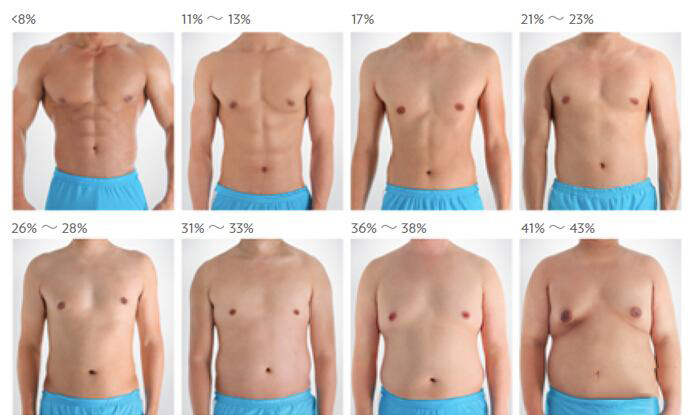What Should My Body Fat Percentage Be?
Before we get into how to measure your body fat percentage, let’s talk about the number you should be aiming for. You’ll find different charts out there giving you breakdowns of healthy-to-unhealthy body fat percentages. Here’s the body fat percentage chart from the American Council on Exercise:
| Description | Body fat % (women) | Body fat % (men) |
| Athletes | 14%–20% | 6%–13% |
| Fitness | 21%–24% | 14%–17% |
| Acceptable | 25%–31% | 18%–24% |
| Obesity | >32% | >25% |
These are, of course, just general recommendations. The big takeaway is that if you’re a dude and your body fat percentage is greater than 24%, you should probably work on losing some body fat.
If you’re not above 24%, I’d say it’s up to you and your personal goals/desires/commitment-level as to where you’d like your body fat to be. Take it from someone who attempted to reduce his body fat to the 6%-13% range: it’s hard. You’ll be hungry. You’ll be cranky. You’ll be distracted at work. Your performance in the gym will suffer (contrary to popular belief, you can’t get both ripped and strong at the same time). I aborted that mission about a month into it. I can’t imagine what it must be like to be a bodybuilder who aims to get down to just “essential body fat” which is like 3%-5%. There’s a reason they only go that low for competitions and don’t look like that the rest of the year. It’s not healthy or sustainable.
Since that experiment in trying to look shredded, I’ve decided to keep my body fat percentage in the 15-17% range. Sure, I don’t look like Brad Pitt in Fight Club, but I feel good and am happy with how I look. It works for me. Peg a goal that works for you.
Tape Measure Method
The tape measure method is the cheapest and most accessible method to measure your body fat. All you need is a measuring tape; companies make ones specifically for measuring the body, but any soft measuring tape will work.
Despite its simplicity, research says that, when done correctly, the error rate for the tape measure method can be as low as 2.5–4.5% body fat, which is nearly as low as the most expensive, high-tech methods on this list. Accuracy depends mainly on the accuracy of your measurements.
There are two ways to get a body fat percentage based on tape measure measurements: 1) the US Navy Body Fat Formula, or 2) the YMCA Body Fat Formula.
For men, the US Navy Body Fat Formula requires two measurements (all measurements should be done in inches and pounds):
Neck: The neck tape measurement measures the neck’s circumference immediately above the Adam’s apple.
Waist: The waist tape measurement measures the circumference of the narrowest waist level, located midway between the lowest rib and the top of the hip bone.
After you get those measurements, insert them into this formula:
Body Fat Percentage (%) = 86.010 x log10 (abdomen – neck) – 70.041 x log10 (height) + 36.76
Or, if you don’t want to bust out your slide ruler to calculate your body fat, just insert your measurements into this online US Navy Body Fat Formula Calculator.
The YMCA Body Fat Formula just requires you to measure your waist circumference.
For men, the YMCA Formula looks like this:
Men’s Body Fat Percent = – 98.42 + 4.15a – 0.082b / b
Where a = waist measurement in inches and b = your weight in pounds.
Or you can just input your measurements into an online YMCA Body Fat Formula Calculator.
Consistency Counts
Whichever method you choose to measure your body fat, you have to be consistent with it, continually using the same method, at the same intervals, at the same time of day.
You’ll find different recommendations out there on how often you should weigh/measure yourself, but I’d personally recommend doing it weekly. Given the way that certain meals and workouts create changes in your body composition (e.g., you’re invariably going to weigh more the day after lifting weights because the resulting inflammation causes you to retain water), monitoring day-to day-fluctuations isn’t especially useful; yet, you want to check in on your body often enough to remain mindful of whether your fat level is trending up or down. While even once-a-week measurements can be prone to meaningless fluctuations, over the months they give you useful, accurate trend lines as to how you’re doing.
If you do decide to measure yourself weekly, always do so on the same day of the week; I like Fridays, because I tend to eat more on the weekend, which creates a temporary weight gain (largely water) in the subsequent days.
In addition to measuring yourself at regular intervals, you should also do your measurements at the same time of day. Body composition fluctuates throughout the day, as eating and drinking causes muscles to store glycogen and water. If you measured your body fat in the morning one day and then in the evening the next, you’re going to get significantly different results.
Create your own routine, stick with it, and track your progress (and regressions — there will always be some and that’s okay!) over time.

0 Comments